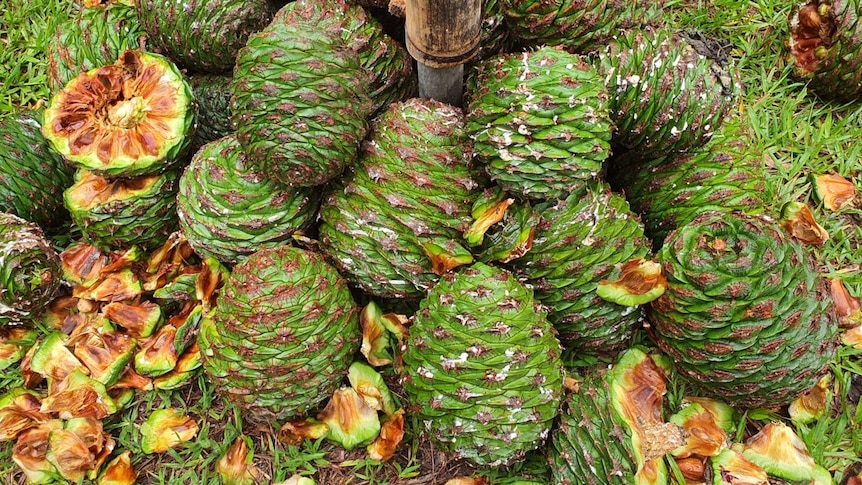An ancient native nut once eaten by dinosaurs has huge potential to be part of the booming Indigenous bush food industry, according to new research led by the University of Queensland.
Brazilian-born scientist Jacqueline Moura Nadolny was aware of walking a sensitive line between examining new uses for bunya nuts without exploiting First Nations’ knowledge and food sovereignty.
The PhD candidate said the bunya nut was not only nutritious and tasty, rich in protein, a healthy resistant starch, amino acids, minerals, omega-3 and omega-6 fatty acids but undervalued by non-Indigenous Australians.
Ms Moura Nadolny studied seeds from the bunya nut’s football-sized spiky cones, struck by similarities to the Pinhao pine nut in southern Brazil.
South Americans eat the smaller, red-skinned pine nut boiled, roasted and salted as a snack, ground into gluten-free flour and brewed into beer.
“I found out that they were actually from the same family, just a different species,” Ms Moura Nadolny said.
“The name of the family is Araucariaceae and there are 21 species around the world but only three of them are edible by humans.”
culture and cuisine
loading
For thousands of years Aboriginal nation groups journeyed to Queensland’s Bunya Mountains and Blackall Range, gathering when the large cones weighing up to 10 kilograms, dropped from an ancient species of pine tree towering up to 50 meters high.
Each cone can contain up to 100 nuts. the Araucaria bidwillii tree dates back to the Jurassic period, at least 145 million years ago.
Pre-COVID, modern bunya nut festivals held on the Sunshine Coast revived ancient traditions that were severely disrupted by European settlement.
“[Traditionally] there were very big festivals that used to get held every couple of years when there was a bumper crop of bunya nuts,” Indigenous academic Odette Best said.
“They were festivals that went for sometimes weeks at a time, marriages were struck, ceremony would be done, feasts would be prepared and a lot of cultural business would occur.”
The professor in nursing at the University of Southern Queensland, who has a keen interest in food sovereignty and researches First Nations history, provided guidance to Ms Moura Nadolny about her people’s ancient food.
“For her and for me there was a real interest around how I could be on one continent and her people are on another continent and yet there’s an incredible similarity between the nuts [and the traditions around them].”
Professor Best’s favorite way of eating bunya nuts is cooked in coals until the tough husk pops. She also makes a “really beautiful” emu and bunya nut stir fry.
“Odette helped me to collect the bunya nuts and told me about the way they prepared it, the history, which was amazing,” Ms Moura Nadolny said.
“And she has been helping me to write as well because I don’t want to just put my results in a paper and publish.”
“I want to have this Indigenous knowledge on the paper and show how important they are to Indigenous communities.”
Her PhD project with UQ’s School of Chemical Engineering and the Queensland Alliance for Agriculture and Food Innovation’s Center for Nutrition and Food Sciences, compared roasted bunya nuts to boiled bunya nuts — benchmarking them against the sweeter chestnut.
A team of panelists investigated their aroma, flavor and texture.
“Chestnuts are much more sweet, bunya nuts are more savory and a little more bland,” Ms Moura Nadolny said.
Boiling bunya nuts made them softer and more moist while roasting made them drier. Flour, beer, cakes, bread, curries, snacks and stir fries are all potential uses. Frozen, they last at least two years.
Ms Moura Nadolny’s goal is to make bunya nuts more accessible by working with Aboriginal communities.
“If you could find in the supermarket, as we find chestnuts, it would be amazing,” Ms Moura Nadolny said.
While praising the research, Professor Best was cautious about the next step.
“We just don’t want non-Indigenous people exploiting Indigenous foods and making an industry out of it because you can’t walk into a supermarket these days without Indigenous food flavorings being utilized in absolutely everything, and the reality is very little of that kickback goes to Indigenous communities,” she said.
“There’s a sense of hesitancy amongst a lot of Indigenous people about ‘Oh this is just the next wave of colonization and taking of knowledge and being utilized by non-Indigenous people and being made into products that can be sold and a lot of money made from them’.
“Jacqueline’s not exploitative, she wants and she understands that hopefully we can get Indigenous involvement into this … that actually sees stuff being done or created that’s Indigenous owned and run.”
.
